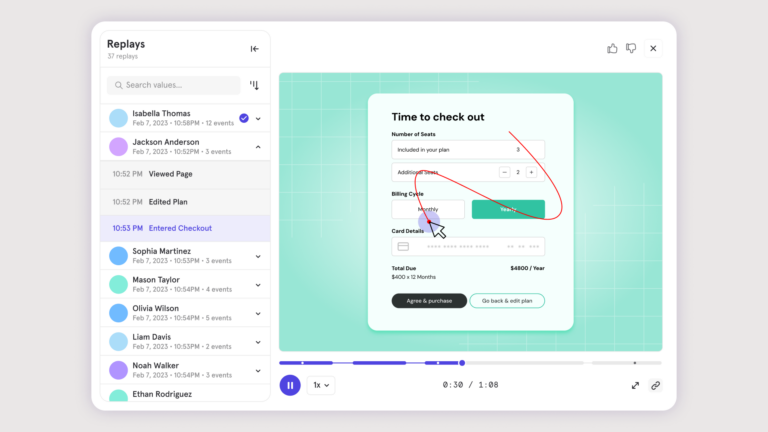What is a heat map?
A heat map is a 2-dimensional representation of data using colors ranging from green to red. Businesses use heat maps to visualize and understand user behavior on their website or app. Some of the information heat maps display includes where on a page users click, how far down a page they scroll, what areas on the page they look at, and even what parts they ignore.
What do digital product managers, marketers, designers, and developers all have in common?
They all need information about how users interact with their product, whether that’s a website or an app.
Helping these people understand user behavior with self-serve analysis is one of the main reasons Mixpanel exists. We want to give stakeholders the data they need to make smart, informed decisions about their products. There are many different ways to gain those insights into user behavior.
One of the most established methods to track patterns and visualize data is by creating heat maps.
What is a heat map?
A heat map is a 2-dimensional representation of data using colors, usually from green to red. Businesses use heat maps to visualize and understand user behavior on their website or app. Some of the information heat maps display includes where on a page users click, how far down a page they scroll, what areas on the page they look at, and even what parts they ignore.
Heat maps may feel like a modern invention, but they’ve actually been around for a long time (PDF download). In the late 1800s, officials in Paris used hand-drawn heat maps to track social trends across different districts. When it came to finding a tool to modernize website analysis, heat maps were a great fit because they’re intuitive and easy to read.
How heat maps work
Heat map software for digital product development collects data about website or app performance. It then displays those data points—not as a bar graph or a slice of a pie chart, but as warm-to-hot or cool-to-cold clusters.
Here is an example of what a website heat map looks like.
Red areas represent the areas that visitors interact with the most, followed by orange, yellow, and finally green (or occasionally blue) to show which parts of the page they interact with the least.
Heat map examples
Different types of digital heat maps provide different information about how people interact with a specific web page, including what they click on, where they click, what they ignore, and how far down a page they scroll.
Here are a few examples of website or app heat maps with different purposes:
- Click heat maps show user click patterns
- Movement heat maps track mouse movement
- Scroll heat maps computes show how far down a page visitors scroll
- Geo heat maps identify audience locations
- Attention heat maps illustrate and quantify page engagement
Heat maps are great tools for marketers, product managers, UX researchers, and designers. They give you a deeper understanding of website visitor behavior and can help you understand how users are behaving. They’re easy to understand and visually appealing.
Heat maps can also help uncover opportunities. If you see many users trying to click on an element that doesn’t lead anywhere, you can add a link. If people are only interested in the top third of your page, you can move important information up (or even cut your content).
But it’s important to know that heat maps don’t always offer a complete picture.
Drawbacks of heat maps
Heat maps are an aggregation of the behavior and inputs from thousands of different users. They can help you understand what users are doing on any given web or app page, but they don’t show what users were doing before or after they took that action. You don’t get a sense of the user journey, only snapshots of where actions take place.
Heat maps help you understand what users are doing, but they don’t give you much if any information about why.
Heat maps vs. session replays
Session replays are video playbacks of individual user sessions. Like heat maps, they give viewers valuable insight into how real users are interacting with their website or product.
If heat maps show a snapshot of how many different users behave in one moment, you could say that a session replay is the opposite. With a session replay, you can see a recording of one user’s full journey to get the full picture of how users are interacting with your product—and most importantly, why they’re behaving that way.
Being able to view session recordings isn’t new, and lots of tools specialize in offering session recordings specifically. But with ever-growing tech stacks, switching between tools to view quant data (like conversion rates) and qual data (like session replays) becomes tedious and expensive.

Mixpanel’s Session Replay gives you the ability to identify issues in quantitative product analytics reports and then jump directly to view individual recordings showing that issue—all in the same platform, without interrupting your workflow.
Here’s an example:
Let’s say you’re analyzing a funnel in Mixpanel and you notice a lower purchase conversion rate for users on Chrome vs. Safari.
With Session Replay, you can dive deeper by viewing sessions of users who didn’t convert and watch a recording of their behavior at that point.
In other words, you can use quantitative data as an entry point for further investigation, and then complete your analysis with qualitative data, all within a single tool. Session Replay gives you that voice of customer data within your existing workflows.
Simplicity is key
Both heat maps and session replays are easy to understand and even easier to use. They don’t require technical data analysis skills, and they give you access to real voice of customer data—without the added time, expense, and inconvenience of interviewing individual customers.



